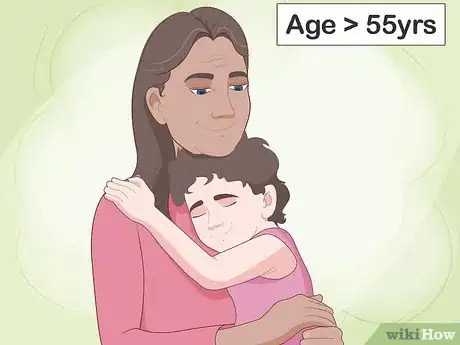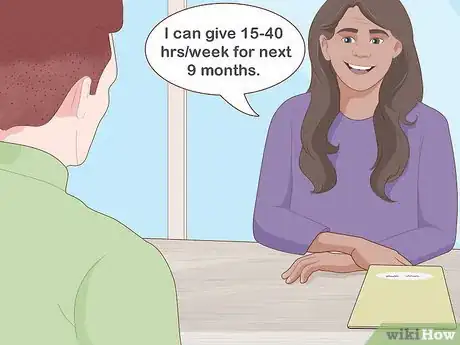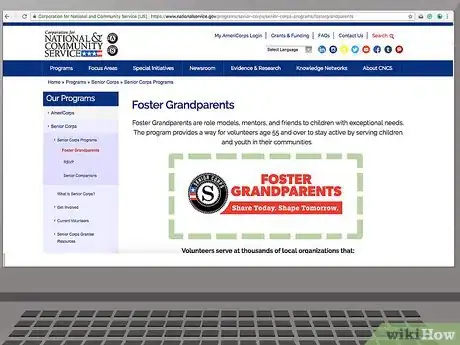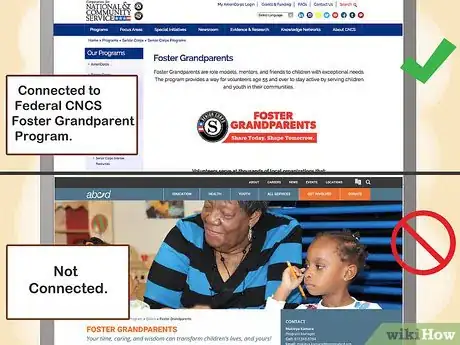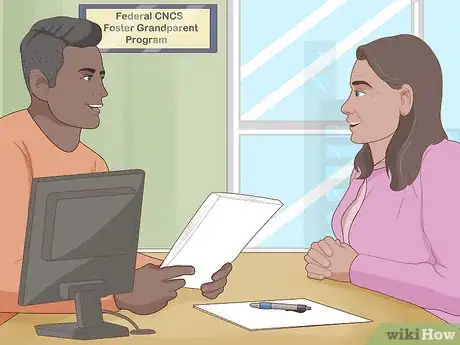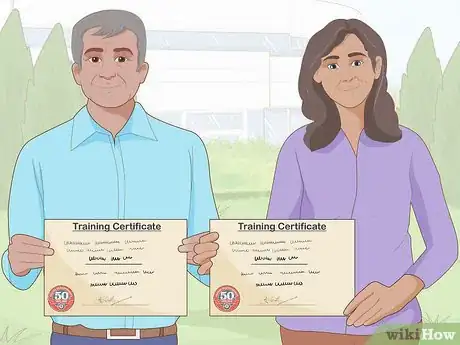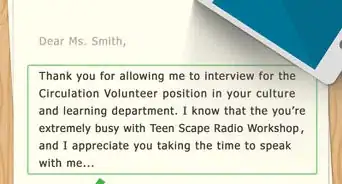This article was co-authored by Clinton M. Sandvick, JD, PhD. Clinton M. Sandvick worked as a civil litigator in California for over 7 years. He received his JD from the University of Wisconsin-Madison in 1998 and his PhD in American History from the University of Oregon in 2013.
wikiHow marks an article as reader-approved once it receives enough positive feedback. In this case, 92% of readers who voted found the article helpful, earning it our reader-approved status.
This article has been viewed 53,123 times.
Foster Grandparents is a national program in the United States established in 1965 for the purpose of pairing senior citizens with at-risk children. Foster grandparents volunteer their time to enhance the quality of life of children and youth in preschools, homeless shelters and other community programs. As a volunteer, you might help rock, feed, and play with babies. You may help preschool children learn colors and shapes and develop fine and gross motor skills. You could also tutor older children in reading and other subjects in elementary school. Low-income seniors may be eligible to receive a stipend for their service.
Steps
Determining Your Eligibility
-
1Be at least 55 years old. The first requirement for participants in the Foster Grandparents program is that you must be at least 55 years old. There is no upper age limit for involvement in the program.[1]
-
2Satisfy a physical examination. To enroll in the Foster Grandparents program, you must have a physical examination. As a result of this, you must be physically capable of serving children with exceptional physical or emotional needs, or children who are limited in their social, emotional or academic development.[2]
- The details of the physical examination will be established by each local office. You will need to contact your local facility to get more information. In general, you will need to have your own doctor conduct a physical exam and provide a statement that you are mentally and physically capable of serving as a volunteer.
Advertisement -
3Meet certain income guidelines. The Foster Grandparents program provides a stipend (payment) to participants who fall within certain federally-set income guidelines. If you exceed the income guidelines, you may still participate in the Foster Grandparents program, but you are not eligible to receive a stipend.[3]
- For 2016, the maximum income for a single individual is set at $23,760. The level increases for two, three or four family members. The income level is also higher for individuals living in Alaska or Hawaii.
-
4Be available for minimum time requirements. To participate, you must be willing to volunteer between 15 and 40 hours per week. You must also be willing to participate for at least nine months out of the year. If you cannot meet these time requirements, you may be able to serve for less time, but you would have to talk with local organizers for permission.[4]
-
5Submit to a criminal history check. Agencies that participate in the Foster Grandparents Program are required to conduct a National Service Criminal History Check on all employees and volunteers. This includes Foster Grandparents. You will need to complete a form that the office will provide. They will then conduct a background check and determine your eligibility. You will be ineligible to participate if you:[5]
- Are listed, or required to be listed, on a sex offender registry.
- Have been convicted of murder.
- Are unwilling to consent to the background check.
- Are found to have made a false statement in connection with a program’s inquiry concerning your criminal history.
Finding an Organization Near You
-
1Learn about the Corporation for National and Community Service. The Corporation for National and Community Service (CNCS), is a federal agency that helps Americans find ways to provide service to help others. The CNCS includes AmeriCorps, Senior Corps (which administers the Foster Grandparents program), Volunteer Generation Fund, and many other individual programs. The CNCS provides federal funding and support to local programs, which in turn supervise individual Foster Grandparents.[6]
- You can find out more about the national Foster Grandparents program by visiting its website at http://www.nationalservice.gov/programs/senior-corps/senior-corps-programs/foster-grandparents.
-
2Look for service opportunities on the CNCS Foster Grandparents website. On the national Foster Grandparents website, at http://www.nationalservice.gov/programs/senior-corps/senior-corps-programs/foster-grandparents, you will see the heading, “Find a Volunteer Opportunity.” In that space, enter the phrase “Foster Grandparent.” Then enter your city, state or zip code and click on “Find Opportunities Now.” You will be redirected to a list of local agencies that participate in the Foster Grandparent program, with contact information for learning more.[7]
- For example, conducting a search from the CNCS website for "foster grandparents" in Denver results in links to Youth and Family Connections, Families First, and Families First Colorado. You can then select each one of those for more information or local contacts.
-
3Conduct a general Internet search. Using any general search engine, search for the phrase “Foster Grandparents.” To narrow your search, you may wish to add the name of your city or state. You should find a list of agencies that participate in the program.
- For example, a general search for “Foster Grandparents” and “Boston” will link you to the Action for Boston Community Development, the Massachusetts Service Alliance, Volunteer Match, Elder Services of Catholic Charities, and many others. You will need to review each result to find projects that are near you that you wish to contact.
- Make sure that the projects you contact are connected to the federal CNCS Foster Grandparents program. For example, a search for “Foster Grandparents” and “Boston” provides a link to Elder Services of the Catholic Charities. Upon further review, this program is not connected to the CNCS Foster Grandparents program. You may certainly still choose to work with this group. Just realize that the information provided in this article may not apply.
-
4Contact the local agency. The CNCS Foster Grandparents program operates by providing federal funding and support to local agencies. Each local agency is self-functioning. You will need to find an agency in your area and contact its administrator for more information. When you find an agency that you believe will work for you, you can then proceed with the application process and begin volunteering.[8]
Applying and Volunteering
-
1Participate in an interview. After you express interest in joining the Foster Grandparent program at a facility near you, you will be invited to participate in an interview. The interview may be in person, by telephone, or even through the computer via Skype or some other software communication program. During your interview, you can expect to be asked about any of the following:[9]
- Your background, particularly with regard to working with or raising children.
- Your hobbies or interests, and any that you might share with children.
- Your level of interest and motivation to serve needy children.
- Your work and volunteer history.
- Your income eligibility.
- The training and support that will be provided to you.
- Availability of transportation in some areas.
- Types of assignments that may be given to you, and your ability to perform assigned duties without support.
-
2Wait for a selection decision. The Foster Grandparents administrator will make individual decisions on everyone who applies. If the number of applicants at any one facility is high, then not everyone who expresses interest may be accepted. Decisions for acceptance are made based on some of the following criteria:[10]
- Level of interest and motivation to work with needy children.
- Financial need of the applicant.
- Ability to serve 15 to 40 hours per week, to work with two or more children.
- Flexibility in accepting assignments, including assignments in private homes.
- Ability to provide your own transportation. In some areas, the facility may be able to provide transportation for Foster Grandparents, but having your own transportation to and from the facility or other assigned locations may make you a more preferable applicant.
-
3Participate in training. If you are selected into the program, you will receive 20 hours of training before you begin working with children. You will then receive an additional 20 hours of training, spread out over several weeks, after your service begins. The training is designed to acquaint you with the program, familiarize you with the individual location, and train you to work with the children. Some particular topics that are included in the training are:[11]
- Visiting service locations, so you can participate in selecting an assignment.
- Familiarizing you with the children’s special needs and strategies you can use to best serve them.
- Discussing the roles and activities of Foster Grandparents.
- Providing you with information about local community services so you can help advocate for needy children.
-
4Provide your Foster Grandparent service. Once you have been selected and have completed your training, you will be given an assignment. This assignment will be based on the agency's need as well as the interests that you expressed in your interview. If you would like a particular assignment or would like a change, speak with the local administrator. You must meet the minimum expectations of at least 15 hours per week, although you may serve up to 40 hours per week. Be sure to arrive when expected, and plan to stay as long as you commit. Your particular assignment will vary, based on the needs of the individual children and your abilities and interests. You will always have contact with the Foster Grandparents staff, so you can get help and support as needed.[12]
Warnings
- Examine your desire to be a foster grandparent and be sure you are willing to donate the necessary hours every week. The foster grandchild assigned to you will come to depend upon your weekly involvement.⧼thumbs_response⧽
References
- ↑ http://www.nationalservice.gov/sites/default/files/documents/2016%20FGP%20Handbook%20Full%20Draft.508%20v081116.pdf
- ↑ http://www.nationalservice.gov/sites/default/files/documents/2016%20FGP%20Handbook%20Full%20Draft.508%20v081116.pdf
- ↑ http://www.nationalservice.gov/sites/default/files/documents/2016%20Senior%20Corps%20Income%20Guidelines.FINAL_.pdf
- ↑ http://www.nationalservice.gov/sites/default/files/documents/2016%20FGP%20Handbook%20Full%20Draft.508%20v081116.pdf
- ↑ http://www.nationalservice.gov/sites/default/files/documents/2016%20FGP%20Handbook%20Full%20Draft.508%20v081116.pdf
- ↑ http://www.nationalservice.gov/
- ↑ http://www.nationalservice.gov/programs/senior-corps/senior-corps-programs/foster-grandparents
- ↑ http://www.nationalservice.gov/programs/senior-corps/senior-corps-programs/foster-grandparents
- ↑ http://www.nationalservice.gov/sites/default/files/documents/2016%20FGP%20Handbook%20Full%20Draft.508%20v081116.pdf
- ↑ http://www.nationalservice.gov/sites/default/files/documents/2016%20FGP%20Handbook%20Full%20Draft.508%20v081116.pdf
- ↑ http://www.nationalservice.gov/sites/default/files/documents/2016%20FGP%20Handbook%20Full%20Draft.508%20v081116.pdf
- ↑ http://www.nationalservice.gov/sites/default/files/documents/2016%20FGP%20Handbook%20Full%20Draft.508%20v081116.pdf
